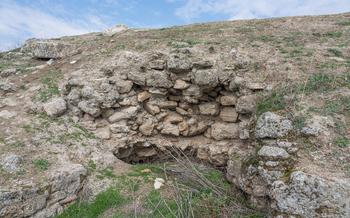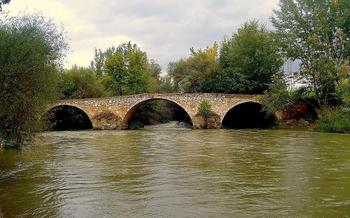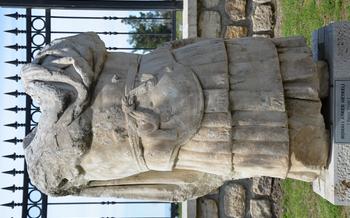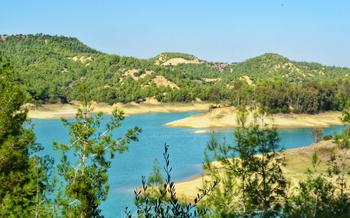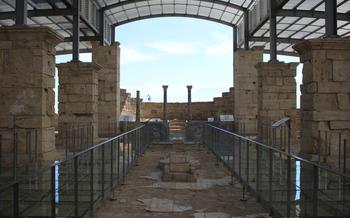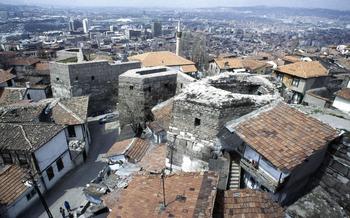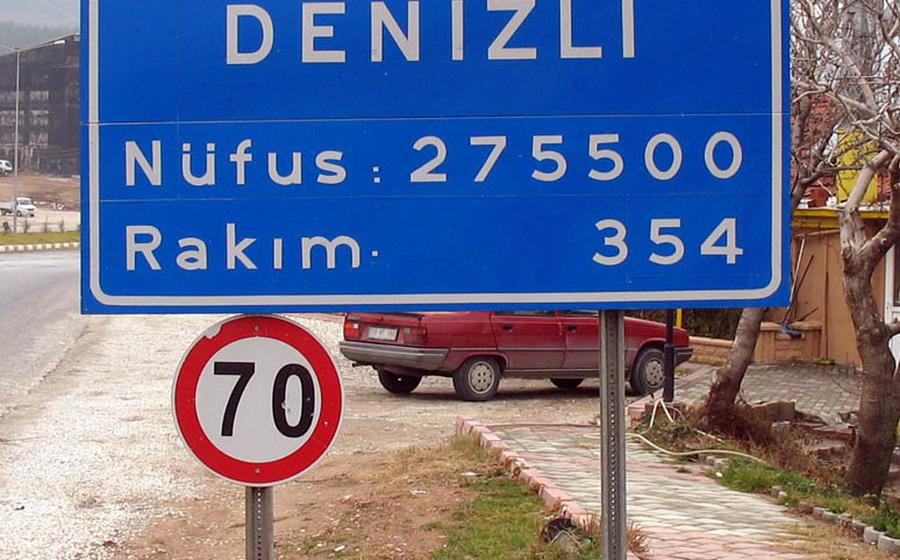
Merkezefendi Cemetery
- Unveiling Merkezefendi Cemetery: A Journey Through History
- Unveiling the Ancient City of Laodicea
- Discovering the Hidden Church
- Experiencing the Local Culture
- Paying Respects to the Deceased
- Immerse in the Natural Beauty
- A Place of Reflection and Contemplation
- Unraveling the Stories of History
- Preserving Cultural Heritage
- Engaging with Local Crafts
- Exploring the Museum of Denizli
- Savoring Local Delights
- Capturing the Essence of the Cemetery
Unveiling Merkezefendi Cemetery: A Journey Through History
Nestled in the heart of Denizli, Turkey, lies the Merkezefendi Cemetery, a historical treasure trove that invites visitors to embark on a journey through time and culture. Steeped in rich history, the cemetery is the final resting place of numerous Sufi saints, renowned figures, and ordinary citizens who have shaped the tapestry of Denizli's past.
Located in the city center, the cemetery is easily accessible, inviting visitors to explore its diverse architectural styles, from ornate mausoleums to humble tombstones. As a cultural and religious hub, the Merkezefendi Cemetery holds profound significance for the local community, serving as a place of pilgrimage, reflection, and remembrance.
Unveiling the Ancient City of Laodicea
Buried within the confines of the Merkezefendi Cemetery lies the ancient city of Laodicea, a testament to the rich history and cultural heritage of Denizli. Founded in the 3rd century BC by the Seleucid king Antiochus II, Laodicea flourished as a significant trade and cultural center during the Hellenistic and Roman periods.
As you explore the cemetery, keep an eye out for the remnants of this once-thriving city. Archaeological excavations have revealed impressive ruins, including a well-preserved theater, a colonnaded street, and the remains of a temple dedicated to Zeus. These remnants offer a glimpse into the architectural grandeur and urban planning of Laodicea.
Intriguingly, the city was also mentioned in the Bible, notably in the Book of Revelation, where it was one of the seven churches of Asia Minor. This adds a spiritual and religious significance to the site, attracting pilgrims and history enthusiasts alike.
Unearthing the secrets of Laodicea is an adventure in itself. As you wander through the cemetery, imagine the bustling streets and vibrant markets that once characterized this ancient metropolis. Reflect on the lives of its inhabitants, their customs, and their contributions to the region's rich history.
Discovering the Hidden Church
Within the boundaries of Merkezefendi Cemetery lies a hidden gem - a secluded church that stands as a testament to the rich religious history of the region. While information about its origins remains shrouded in mystery, this enigmatic church has captivated the imaginations of visitors and locals alike.
Built centuries ago, the hidden church boasts a unique architectural style that blends elements of Byzantine and Ottoman influences. Its intricate stonework, arched doorways, and faded frescoes hint at the skilled craftsmanship that went into its construction.
Despite the passage of time and the changing religious landscape, the church has remained remarkably well-preserved, thanks to the efforts of local communities who have recognized its cultural and historical significance.
Venturing into the hidden church is a journey back in time. Visitors can explore its dimly lit interior, marvel at the remnants of ancient murals, and imagine the prayers and ceremonies that once took place within its walls.
The church's secluded location adds to its allure, creating a sense of tranquility and isolation that invites contemplation and reflection. It is a place where visitors can connect with the past and gain a deeper appreciation for the diverse religious heritage of Turkey.
Experiencing the Local Culture
The Merkezefendi Cemetery is deeply embedded in the local culture and traditions of Denizli. It serves as a gathering place for community events, festivals, and ceremonies that celebrate Turkish heritage. During these occasions, the cemetery transforms into a vibrant hub of activity, showcasing traditional music, dance, and culinary delights. Visitors can witness locals paying their respects to the deceased while also engaging in lively conversations and sharing stories about their ancestors.
One of the most significant events held at the cemetery is the annual "Mevlid-i Nebi" celebration, which commemorates the birth of the Prophet Muhammad. This festival attracts thousands of pilgrims and visitors who gather to recite prayers, distribute food, and engage in communal activities. The cemetery's serene atmosphere provides a backdrop for these joyous celebrations, fostering a sense of unity and spirituality among the participants.
Interacting with the locals who frequent the cemetery offers a profound insight into Turkish culture and beliefs. Visitors can engage in heartfelt conversations with families tending to their loved ones' graves, learning about their customs, rituals, and personal stories. These interactions provide a unique opportunity to gain a deeper understanding of Turkish society and its rich cultural tapestry.
Paying Respects to the Deceased
Visiting Merkezefendi Cemetery is not merely a historical or cultural exploration; it is also a profound experience of paying respects to the deceased. Locals and visitors alike come to the cemetery to honor their loved ones who have passed on, following specific customs and etiquette.
When visiting a grave, it is customary to greet the deceased by saying "Merhaba" or "As-salamu alaykum," expressing both respect and acknowledging their presence. A moment of silence is observed, allowing for contemplation and remembrance.
Traditionally, visitors leave offerings at the graveside, such as fresh flowers, which symbolize beauty, purity, and the transience of life. Some may also leave small stones or pebbles on the grave, representing remembrance and respect.
Prayers and supplications are often recited at the graveside, seeking divine mercy and forgiveness for the deceased. These prayers are a way to express love, gratitude, and the belief in an afterlife.
Honoring the memory of loved ones extends beyond the cemetery visit. In Turkish culture, the tradition of "dua" or prayers for the deceased is deeply ingrained. Family members and friends gather regularly to recite prayers and share memories of the departed, keeping their spirits alive in their hearts.
By observing these customs and traditions, visitors to Merkezefendi Cemetery not only pay their respects to the deceased but also gain a deeper understanding of Turkish culture and its profound connection to its ancestors.
Immerse in the Natural Beauty
The Merkezefendi Cemetery is not just a place of historical and cultural significance; it is also a place of extraordinary natural beauty. Surrounded by a unique landscape and diverse vegetation, the cemetery offers a tranquil atmosphere amidst nature. The serene surroundings provide ample opportunities for bird watching and nature photography enthusiasts. As the seasons change, the scenery transforms, creating a dynamic and picturesque backdrop to the ancient tombs and monuments. Visitors can stroll through the cemetery, admiring the vibrant colors of wildflowers and the lush greenery that envelops the graves. The tranquility of the environment encourages introspection and contemplation, inviting visitors to connect with nature and find solace in its beauty.
A Place of Reflection and Contemplation
Amidst the serene surroundings of the Merkezefendi Cemetery, visitors find solace and tranquility. The site serves as a place for introspection and self-discovery, inviting individuals to seek refuge from the bustling world. The tranquil atmosphere and proximity to nature create an ideal environment for contemplation and reflection.
As you wander through the cemetery, the stories of those who have passed on envelop you, inspiring you to consider the journey of life and the legacy we leave behind. The gravestones and mausoleums, each with its unique inscriptions and symbols, invite you to delve into the lives and experiences of those who now rest here.
Whether you seek solace in solitude or find inspiration in the collective stories of the past, the Merkezefendi Cemetery offers a unique opportunity for contemplation and self-reflection. Take a moment to pause, reflect on the transient nature of life, and find peace in the presence of the eternal.
Unraveling the Stories of History
As you wander through the Merkezefendi Cemetery, you'll discover that each tombstone holds a unique story, waiting to be unveiled. Take a moment to read the inscriptions, and you'll be transported back in time, meeting prominent figures from Denizli's rich history. From poets and artists to religious leaders and war heroes, the cemetery is a treasure trove of forgotten narratives and hidden histories.
One of the most intriguing tales is that of Süleyman Efendi, a renowned Sufi saint known for his wisdom and healing abilities. His tomb, adorned with intricate carvings and calligraphy, attracts pilgrims from all over the country who seek blessings and guidance. Another notable figure is Mehmet Pasha, a valiant warrior who fought bravely in the Ottoman army. His tomb stands as a testament to his courage and sacrifice, inspiring visitors with its grandeur and historical significance.
These are just a few examples of the many captivating stories that await you at the Merkezefendi Cemetery. As you delve deeper into the lives of the deceased, you'll gain a profound appreciation for the region's rich cultural heritage and the remarkable individuals who shaped its history.
Preserving Cultural Heritage
The Merkezefendi Cemetery is not merely a burial ground but a repository of rich cultural heritage that merits protection and preservation. Recognizing its significance, local authorities and organizations have undertaken initiatives to safeguard this unique site. Regular maintenance and restoration efforts ensure that the cemetery's architectural integrity and aesthetics remain intact. Additionally, ongoing research and documentation projects aim to uncover and record the stories and histories associated with the cemetery. These efforts not only preserve the tangible aspects of the site but also contribute to the intangible cultural heritage of Denizli.
However, protecting the cemetery from the ravages of time and human neglect poses several challenges. Environmental factors, such as erosion and weathering, can damage the delicate structures and inscriptions. Uncontrolled tourism and development can also threaten the site's authenticity and integrity. To address these challenges, sustainable tourism practices and responsible management strategies are being implemented. These measures include visitor education programs, controlled access, and the involvement of local communities in preservation efforts. By working together, stakeholders can ensure that the Merkezefendi Cemetery remains a vibrant and enduring symbol of Denizli's cultural heritage for generations to come.
Engaging with Local Crafts
As you explore the Merkezefendi Cemetery, take the opportunity to delve into the vibrant world of local crafts. Near the cemetery, you'll find a treasure trove of shops and artisans showcasing their skills and creations. Discover the intricate art of Turkish carpet weaving, where vibrant colors and traditional patterns come together to create masterpieces. Witness the delicate craftsmanship of pottery, as artisans mold clay into beautiful forms, each piece a unique work of art. Explore the intricate designs of jewelry, where gold, silver, and gemstones are transformed into stunning adornments. Learn about the techniques and processes involved in creating these crafts, and appreciate the skill and dedication of the local artisans. Support their livelihoods by purchasing unique souvenirs that will serve as lasting mementos of your visit to Denizli. Immerse yourself in the rich cultural heritage of the region as you engage with the local crafts, taking home treasures that embody the essence of Turkish artistry.
Exploring the Museum of Denizli
To further delve into the cultural heritage of Denizli, a visit to the Museum of Denizli is highly recommended. Situated in the heart of the city, the museum houses a diverse collection of artifacts and exhibits that provide insights into the region's rich past and its connection to the Merkezefendi Cemetery.
The museum's collection includes archaeological findings from various sites across Denizli, including ancient Laodicea. Visitors can admire intricate pottery, jewelry, and sculptures that showcase the artistry and craftsmanship of past civilizations. Additionally, the museum houses a section dedicated to the history of the Merkezefendi Cemetery, featuring tombstones, inscriptions, and personal belongings that shed light on the lives of those buried there.
By exploring the Museum of Denizli, visitors can gain a deeper understanding of the region's historical significance and its connections to the Merkezefendi Cemetery. The museum serves as a valuable resource for those seeking to delve into the cultural heritage of Denizli and appreciate the enduring legacy of the past.
Savoring Local Delights
No cultural exploration is complete without indulging in the local cuisine. As you wander through the streets surrounding Merkezefendi Cemetery, tantalizing aromas will beckon you towards traditional Turkish restaurants and cafes. Take this opportunity to savor the flavors and specialties of the region.
Delight in the succulent kebabs, expertly grilled over charcoal fires, and accompanied by fresh vegetables and fragrant herbs. Sample the rich and creamy "lahmacun," a crispy flatbread topped with minced lamb, vegetables, and spices. Satisfy your sweet tooth with delectable "künefe," a shredded pastry filled with melted cheese and drenched in sweet syrup.
Engaging with locals over food is a wonderful way to learn about their culture and way of life. Strike up conversations with friendly restaurant owners, ask about their favorite dishes, and listen to their stories. Embrace the warmth and hospitality of the Turkish people as you savor the flavors of their cuisine.
Insider Tip: For a truly authentic dining experience, venture off the beaten path and seek out hidden gems frequented by locals. Ask your hotel concierge or a local tour guide for recommendations.
Capturing the Essence of the Cemetery
When visiting the Merkezefendi Cemetery, photography enthusiasts have a unique opportunity to capture the beauty and significance of this historic site. While photography is permitted, it is important to be respectful of the religious and cultural significance of the cemetery. Avoid using flash photography, and be mindful of the privacy of visitors who may be paying their respects to loved ones.
To capture the essence of the cemetery, focus on the architectural details of the tombs and the surrounding landscape. Experiment with different angles and perspectives to create visually interesting compositions. The warm, golden light of sunrise and sunset can add a magical touch to your photographs, casting long shadows that accentuate the grandeur of the tombs.
Black-and-white photography can be particularly effective in conveying the timeless quality of the cemetery. This technique can help to create a sense of nostalgia and mystery, allowing you to focus on the textures and forms of the tombs without the distraction of color.
After your visit, take some time to review your photographs and select the ones that best capture the spirit of the Merkezefendi Cemetery. Share your images online or in print, and use them to tell the story of this fascinating place to others.
